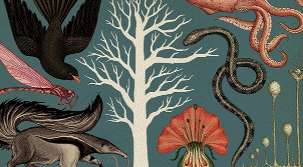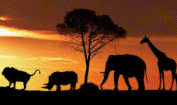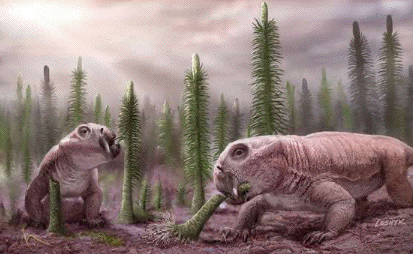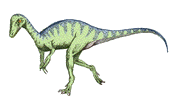The
ecological habitat (ecohab) of a species is
characterized by a number of defining parameters
(defipars) branched out into two major categories:
the abiotic (abi) and the biotic (bio)
ones, as described below,
|
with
|
|
•
The abiotic
defipar
by being the food sources, the water
sources, the light sources, the climate, the
temperature ranges, the altitude, the type
(terrestrial, aquatic, or aerial), and the
territorial boundaries.
|
|
and
with
|
|
•The
biotic
defipar
by
being represented by the living
predators.
|
The
ecohab,
as such, is an ecological fermenting (ecoferm)
arena where the successful species create their
unique ecological enclaves called ecological niches
(ecolons or econiches). An ecological
packing (ecopack or ecopacking) is being
administered to ecohab
by the successful species.
|


|
To
illustrate the ecopacking
mechanism,
we provide a thought scenario, as
follows:
|
 Let
the ecohab
be a grandiose tree and let consider that
a type of bird, identified as the Y-bird,
populates on, and feeds from, the top of the
tree.
Let
the ecohab
be a grandiose tree and let consider that
a type of bird, identified as the Y-bird,
populates on, and feeds from, the top of the
tree.
Now,
assume that another type of bird, identified as
R-bird, has arrived to occupy and to feed
from the tree. A fight will emerge between the
two bird species Y and
R,
pursuant to Darwin's
natsel.
Assuming that the resident
Y-birds
become victorious, for the defeated
R-birds,
two and only two, scenarios could exist: either
the R-birds
perish or they are able to adapt to
occupy the area below the top of the tree. With
that adaptation of the
R-birds,
a peaceful coexistence takes place.
Finally,
let's assume now that the
grandiose
tree
attracts another type of bird, identified as
B-bird. Another fight will commence,
pursuant to Darwin's
natsel,
between the intruding
B-birds
and the two resident birds
Y
and R.
Assuming again that the resident birds become
victorious, for the defeated
B-birds
again the only scenarios that could emerge are
either that they will perish, or that they could
adapt of living at the bottom of the
tree. All that is being illustrated below:
Remark:
From the presented ecopacking
mechanism, one attribute stands out:
the adaptability to change (adaptoc).
Only species that possess an ability to adapt
to an environmental change will survive and
trive, those that do not, will perish.
That
adaptoc
attribute and characteristic of survival was
first recognized in 1859 by Charles
Darwin in his seminal work "On the Origin
of the Species" as marked below:
The adaptoc
inheritance of a species i.e., of the ability of
a species to adapt to its environment
through learning and remembering
is, as we have seen from the ecopacking
mecchanism, essential for its survival. As such,
successful species would incorporate a cognitive
mechanism, called biotelligence, capable
of remembering the "good" and the "bad" of their
environment and using that stored information
for creating or shaping their environment for
better survival conditions.
|
!
|
|
As
such,
because of the paramount role of
biotelligence
in delivering adaptoc,
we
say that species endowed with most
enhanced biotelligence
are best equiped to survive.
(More
information on the subject is to be
found in the Biowareness
page.)
|
.
|
|

On
Speciation Ecopacking
(Specpack)
|
For Charles
Darwin,
the "species problem" was how one would correctly
identify one species from another, in short, how
well-defined species are in the light of their great
varieties. Darwin in his seminal book "On the Origin
of Species" (1859) offered an explanation of HOW
species evolve and diversify, but not WHY some species
can be so close morphologically and biologically to each
other.
 Well,
closeness of some species are due to the ecopacking
that the successful species "packed" into their
ecohab. Well,
closeness of some species are due to the ecopacking
that the successful species "packed" into their
ecohab.
The thought bird example provided above
is an example of such a speciation ecopacking
(specpack).

Defining Terran Life
(Terralife) at its Ultimate Chemical
Level
|
  As
we have seen, plants and algae convert
Carbon
Dioxide
to organic matter through the process of photosynthesis.
Natural
Selection (natsel),
as we have seen,
continuously
transforms the landscape of Life's
ecolons
by
modifying their numbers and bondaries. With the
recognition that the evolution of Life
(evolife) cannot be separated from
natsel,
NASA erroneously defined Life (at
its ultimate chemical level of existence),
As
we have seen, plants and algae convert
Carbon
Dioxide
to organic matter through the process of photosynthesis.
Natural
Selection (natsel),
as we have seen,
continuously
transforms the landscape of Life's
ecolons
by
modifying their numbers and bondaries. With the
recognition that the evolution of Life
(evolife) cannot be separated from
natsel,
NASA erroneously defined Life (at
its ultimate chemical level of existence),
|
as
being a self-sustained chemical system
capable of
Darwinian evolution.
|

|

|
 Well,
that
NASA
definition of Life is unacceptable
in here for the reason of being placed too
higher up in the tiered
evolutionary structure (TES)
of Life.
You see, the origin of Life does not have
its roots in Darwin's
Natural
Selection (natsel)
principle, but its popup
roots are in something totally different as we
have seen in here. Well,
that
NASA
definition of Life is unacceptable
in here for the reason of being placed too
higher up in the tiered
evolutionary structure (TES)
of Life.
You see, the origin of Life does not have
its roots in Darwin's
Natural
Selection (natsel)
principle, but its popup
roots are in something totally different as we
have seen in here.
|
Now,
the POPlife
once formed, was required to have, for its continuous
existence and development, food, defense
(from hostile environmental activity), and
shelter. That trio (food,
defense,
shelter)
and denoted as fodesh, forms the existential
platform (exiPLAT) of Life
that continuously is being chiseled by
Natural
selection (natsel).
  As
such,
we can talk about Life's
objective of existence (obex) as being that of
survival existence (survex), residing on the
exiPLAT.
Using TRUTON's lingo, we say that
Life's
obex
is natsel
modulo survex. As
such,
we can talk about Life's
objective of existence (obex) as being that of
survival existence (survex), residing on the
exiPLAT.
Using TRUTON's lingo, we say that
Life's
obex
is natsel
modulo survex.
Towards
achieving that obex,
natsel
created stunning defense mechanisms against predators
(through elaborate camouflages and
mimicries) that were incorporated also into
strategies for grabbing their preys.
Another
side of Life's
existential expansion of its exiPLAT
is that, through natsel,
it become adept in plundering more rapidly its existing
habitat accelerating, as such, inadvertently, the
depletion of its own habitation. That inadvertent
deterioration, created additional survival pressure for
the Life.
Thus, the emerging accelerated downgrading
tendency of Life's
habitation acted in opposition to the steady
evolutionary uplifting of its exiPLAT.
 Now, in the ecolon,
a skewed ecological balance (skeb) was
progressively shaping up between the two opposing
emerging tendencies (suppression by the dominant
species and degradation of the habitat),
with the degradation
gaining
the upper hand that began now threatening the very
existence of Life.
Now, in the ecolon,
a skewed ecological balance (skeb) was
progressively shaping up between the two opposing
emerging tendencies (suppression by the dominant
species and degradation of the habitat),
with the degradation
gaining
the upper hand that began now threatening the very
existence of Life.
 The
result of that ecological tilt (ecotilt), as
shocking as it may appear to be, that
Life
--at its apex-- becames strangulated by its own
success, setting the seeds, through its strangulated
habitat (stranghab), for its demise, is being now
recognized in here through
The
result of that ecological tilt (ecotilt), as
shocking as it may appear to be, that
Life
--at its apex-- becames strangulated by its own
success, setting the seeds, through its strangulated
habitat (stranghab), for its demise, is being now
recognized in here through

The Finitude Theorem Of Life (FINITOL)
in a Ecolon
|
Life
of
the dominant and most successful living of
any subjugated ecolon
cannot
continue to evolve, develop and expand in
perpetuity.
|
|
 Proofs:
Proofs:
#1.
The evolution of Life is propelled
by Darwin's Natural
Selection (Natsel)
process which, by 5th FURON,
was already proven
to have a finite evolutionary existence. Thus,
the FINITOL
is fully established. A 2nd proof of
FINITOL
is provided below.

|
.
|

|
#2.
Any ecolon
has in it a succesful dominant species
(domispec). That evolutionary success
(evocess) allows
domispec
to increase exponentially the number of its
offspring with no end in sight. But that is in
contradiction to the
Ultimate
Finitude (ULFI)
Theorem
that was derived from point 6 of
The Ultimate
Marks of Creation (UMOCs)
where
it is stated that:
|
"No
physical processes can exist in Nature
without a finite end. We call that
finitude characteristic, the finite
value mark of creation
(FV-UMOC)."
|

 Thus,
the evocess
of domispec
evolves to the critical evolutionary
(critev) point where the
ecolon
has been transformed into becoming the
domispec's
own ecological graveyard (ecograve). Thus,
the evocess
of domispec
evolves to the critical evolutionary
(critev) point where the
ecolon
has been transformed into becoming the
domispec's
own ecological graveyard (ecograve).
|


|
|
The
Grand Corollary of
FINITOL:
Mass Extinctions
(Massexes)
|
1.
The Self-Induced Mass Extinction
(SIMEX)

|

|
|
.
|
  The
dominating species (say, a herbivore), of an entire
habitat say, the terrestrial habitat (terrahab),
will rapidly be able to overpopulate the land. Being a
herbivore, it will gradually deplete the entire
vegetation which was not able to be replenished out the
massive onslaught that it has received. Deprived of the
food (i.e., of the vegetation) and of the oxygen (that
has been produced by the vegetation), that dominant
species was doomed to self-extinction. By the way, that
was exactly what happened with the dinosaur's
extinction. The
dominating species (say, a herbivore), of an entire
habitat say, the terrestrial habitat (terrahab),
will rapidly be able to overpopulate the land. Being a
herbivore, it will gradually deplete the entire
vegetation which was not able to be replenished out the
massive onslaught that it has received. Deprived of the
food (i.e., of the vegetation) and of the oxygen (that
has been produced by the vegetation), that dominant
species was doomed to self-extinction. By the way, that
was exactly what happened with the dinosaur's
extinction.
PS>
BTW:
The human species will have an identical fate to the one
of the dinosaur as expanded further below
and in the next
page.
We are now at the beginning of that self-destructive
phase.

2.
The Outer Induced Mass Extinction (OIMEX)

 Asides from the inner
self-induced mass extinction
(simex)
triggered by a land dominant species, the aquatic
habitat (aquahab) itself could trigger mass
extinction caused by sudden catastrophic events such as
volcanic activity. As such, we can have outer induced
mass extinction (oimex) caused by sudden underwater
volcanic eruptions. Such events occurred indeed in the
past wiping out almost the entire marine life.
Asides from the inner
self-induced mass extinction
(simex)
triggered by a land dominant species, the aquatic
habitat (aquahab) itself could trigger mass
extinction caused by sudden catastrophic events such as
volcanic activity. As such, we can have outer induced
mass extinction (oimex) caused by sudden underwater
volcanic eruptions. Such events occurred indeed in the
past wiping out almost the entire marine life.
The
reason for that catastrophic event was because of the
sudden rise of temperature and depletion of the oxygen
that were at a level where Life
no longer was able to be suported.

3.
Cosmic Induced Mass Extinction (CIMEX)


  Arguably
cosmic induced mass extinction (cimex) events
could also impact the survivability of
Life
on Earth. However the probability of such cosmic
catastrophic event to take place is practically
nonexistent. The massive speculative cosmic theories that
are floating around are just that:
cosmic
academic garbage (cacagar).
The academic literature covering that fantasy needs
indeed to find its proper place in the massive academic
trash that exponentially has been
accumulating. Arguably
cosmic induced mass extinction (cimex) events
could also impact the survivability of
Life
on Earth. However the probability of such cosmic
catastrophic event to take place is practically
nonexistent. The massive speculative cosmic theories that
are floating around are just that:
cosmic
academic garbage (cacagar).
The academic literature covering that fantasy needs
indeed to find its proper place in the massive academic
trash that exponentially has been
accumulating.
|
On
the Re-Emergence of Life After Mass
Extinction
|
From
the central tenets of TRUTON articulated in the
Ultimate
Marks Of (Material) Creation (UMOCs),
we
choose two of them:
one, vested in the permanent
existential mark of creation (PE-UMOC),
which states that
|
"An
existing non-null state can never ever be made
to disappear and thus be reduced or transformed
into Nothingness --an entity devoid of
everything but its own existence." [emphasis
supplied.]
|
and the other, vested in the
multitude
existential mark of creation (ME-UMOC),
which states that
|
"A
material state of existence that was able to be
created in one place, can be created in a
multitude of other places of similar
conditions as there is no rationale from
barring that to happen." [emphasis
supplied.]
|
Armed with those two (2) tenets, we can now formulate
|
First
Foundational Theorem on the Perpetuity of
Life
|
|
No
Mass Extinction will be able to eradicate
all
Life.
|
|
 Proof:
Proof:
Pockets
of Life
will always remain after a mass extinction
because of the variety of
ecological
niches (ecolons)
that populated the affected habitat. The
habitants of those ecolons
will have now a unique oportunity to evolve and
expand considerably their arena of existence by
the void created by the succumbed
ecolons.
A prime example of that unique opportunity
arose with the dinosaur
extinction,
when the mammal evolution exploded abruptly from
the nocturnal to the diurnal life --a subject of
the next page.
|
|
Second
Foundational Theorem on the Perpetuity of
Life
|
|
The
cycle of Life travels and evolves on a spiral
hierarchical tiered path.
|
|
|
|
 Proof:
Proof:
 By
the 1st
Foundational
Theorem
above, a new cycle
of Life (cycol),
commencing after a mass extinction, will never
starts with a clean slate, as it always will
have in it the surviving species. As such, those
survivors will constitute the base of the new
emerging cycol.
Thus,
we can talk about the evolutionary tier
(evotier) of cycol.
By
the 1st
Foundational
Theorem
above, a new cycle
of Life (cycol),
commencing after a mass extinction, will never
starts with a clean slate, as it always will
have in it the surviving species. As such, those
survivors will constitute the base of the new
emerging cycol.
Thus,
we can talk about the evolutionary tier
(evotier) of cycol.
From the available data, we --the human
species-- apparently have arisen and evolved out
of the 5th
mass
extinction (massex).
Now, as a result of our massive overpopulation
and dominance that accelerated exponentially the
pilferage of Earth's natural resources, we (as
in the case of the dinosaur)
have now created the conditions needed for
generating a new mass extinction, the
6th
one, where we are staging our own self-induced
extinction.
|
With
this rather norrow blueprint presented herein on Life's
evolutionary trends, we move on to expand and cover some
other related topics of Evolutionary Biology.
|